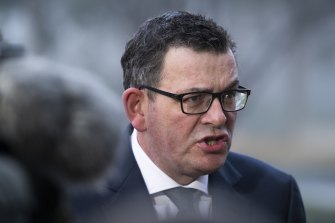Cheap power, net-zero emissions: with a commonsense plan we can have both
In a blow to already spiralling cost of living pressures, Victoria is facing an energy crisis that will mean higher bills and lower reliability.
Energy is a vital essential service, yet Victorians are facing bill hikes between 5 and 18 per cent as energy reliability continues to falter and blackouts continue to threaten local communities.
Victoria is facing an energy crisis.Credit:Jessica Shapiro
The truth is that the current energy crisis gripping Victoria is the result of years of mismanagement and politically motivated policy under the Andrews Labor government.
Between 2014 and mid-2021, Daniel Andrews maintained a ban first introduced by the Napthine Liberal government on exploration for onshore natural gas. Victoria is the highest consuming and most dependent gas state in the nation. This action blocked investment in critical supplies for the local market, meaning higher prices and a freeze on infrastructure development for the best part of a decade.
Further, the closure of Hazelwood power station was a significant blow to Victoria’s energy reliability. Ageing brown-coal generators are damaging to the environment but must be phased out in a structured way, to avoid the price and supply shock still being felt today.
Finally, throughout its almost eight years in office, the Andrews Labor government has put upgrading and preparing our transmission networks in the too-hard basket. This failure to invest has seen blackouts across local communities during dangerous heat-wave conditions and leaves renewable energy too often stuck and wasted on bottle-necked grids.
Victorian Premier Daniel Andrews.Credit:Rhett Wyman
In contrast, the Victorian Liberals and Nationals have a common-sense plan to achieve net-zero by 2050 whilst keeping the lights on and energy bills affordable.
In 2017, the Victorian Liberals and Nationals announced a comprehensive plan to unlock safe, conventional onshore gas reserves whilst maintaining a ban on fracking. This plan included a domestic reserve to keep Victorian gas in the Victorian market – a policy Premier Andrews now describes as “really good policy”, despite having failed to implement it for five years.
The future of energy in Victoria is renewables-driven supported by appropriate storage solutions on a modern grid capable of getting energy from where it is produced to where it is needed.
As technologies and energy storage capacity continues to develop, we need common-sense solutions to support the growing share of renewables in our energy mix. It is a simple fact that gas must be part of supporting this transition and keeping prices low.
Yet instead of doing the heavy lifting to transform our energy system into one that can support a net-zero energy mix in the future, Daniel Andrews remains obsessed with the optics and politics of renewables at the cost of a comprehensive plan.
For years, the Andrews Labor government has told Victorians that more renewables will equal lower energy prices – but for anyone opening an energy bill, they know that despite all these promises – power prices simply keep going up.
Adding in more and more renewables without any proper plan to transmit, store or underpin this power is no longer good enough.
Across Western Victoria right now, solar and wind generators are throwing away up to 7 per cent of their generated power year-on-year due to crippling bottlenecks on transmission networks. This is now a barrier to new renewable projects being developed.
At the same time as power prices are going up due to a lack of supply, clean renewable power in being thrown away because of Andrews’ mismanagement of the grid.
Cutting ribbons on wind and solar farms may be good politics, but without a comprehensive plan for energy transition and energy transmission it will not create a sustainable energy system we need to achieve net-zero, keep prices low and get energy where it’s needed, when it’s needed.
The Victorian Liberals and Nationals have committed to improving the Western Victoria transmission network by upgrading the existing terminal station at Bulgana. This plan will create an additional 1800 MW-worth capacity for renewable energy generation in regional Victoria to flow into Victoria’s electricity grid. That’s the equivalent of around 500 new wind turbines and exceeds the capacity of the Yallourn power station – which will be decommissioned by 2028.
Net-zero by 2050 is a bipartisan issue in Victoria and energy no longer needs to be a debate between lower prices and lower emissions.
The Victorian Liberals and Nationals will take a holistic approach to fixing our energy system, so families and small businesses have the cheap bills needed to grow and future generations can enjoy a safe, clean and sustainable environment they deserve.
Most Viewed in Politics
From our partners
Source: Read Full Article

